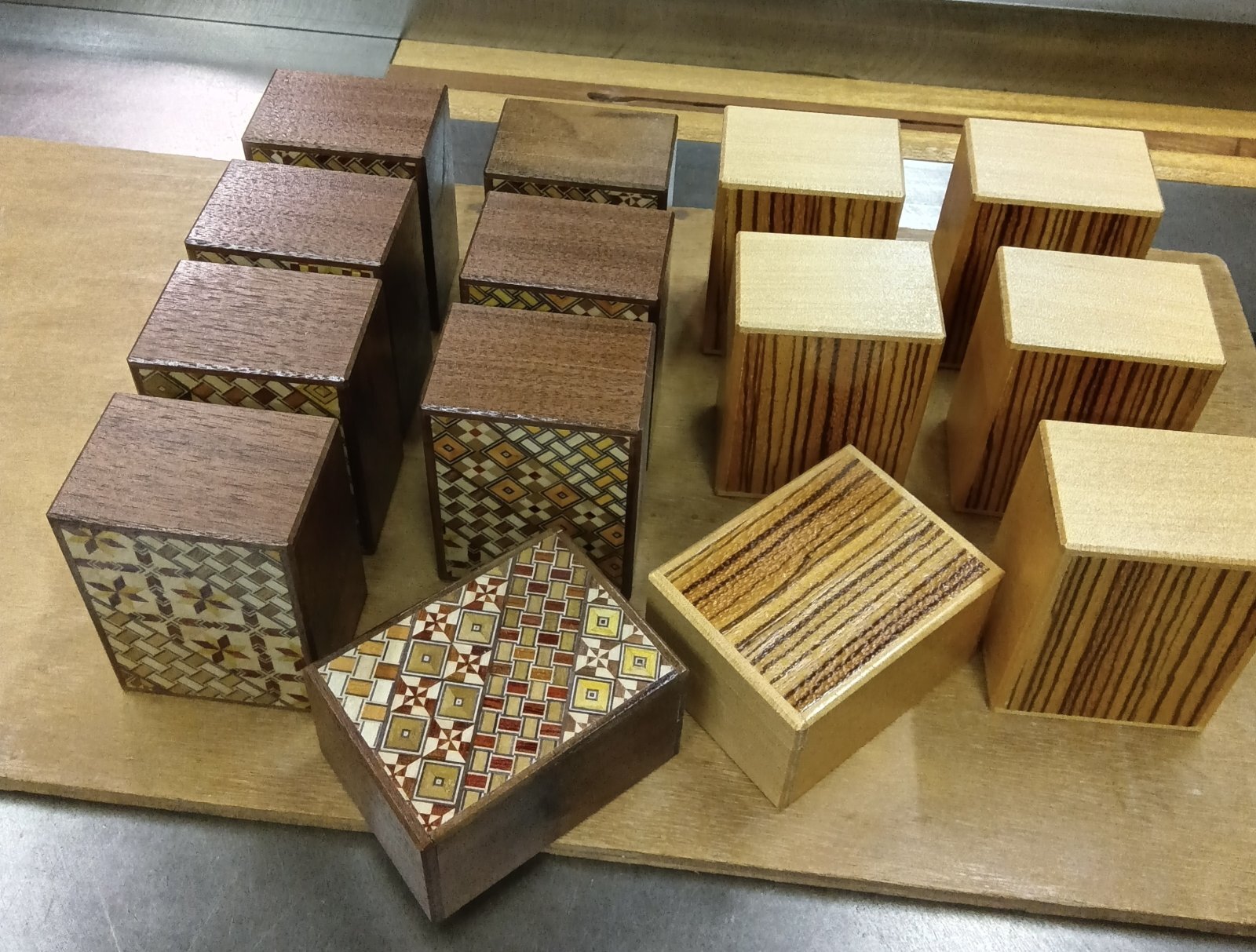Paint sticking
It’s sunny again from the morning today, and it looks like it’s going to be another hot day… 😅
This afternoon, I have some errands to run, so I’ll be going back home by noon. So I’m writing this blog now, in the morning. Because of that, I’m only doing light tasks and office work today — no regular production work.
When I arrived this morning, I checked several 3-sun 18-step boxes that I finished base-coating yesterday. The traditional Yosegi and walnut designs are being made based on requests from overseas shops. The zebrawood type is planned for other sales.
During the base-coating process, some of the mechanisms tend to stick together, so I need to separate them as soon as possible. While the surface of the paint dries in about 1–2 hours, it actually takes around 24 hours for the inside to fully harden. So even if a few hours have passed and the parts are already sticking, it’s still worth moving them a little. If I wait the full 24 hours, they’ll be stuck too firmly and much harder to separate.
Over the years, I’ve learned various ways to unstick these parts through experience, but even so, if they stick too much, it can be very difficult to remove them. Compared to other types of puzzle boxes, Himitsu-bako uses more delicate parts. If I try to force the mechanism loose after the paint has hardened, it can break.
That’s why, even though it takes extra time, it’s very important to move the mechanism two or three times during the finishing process to prevent it from getting stuck. This is especially true for the 3-sun 18-step type, which is quite delicate — I’ve made plenty of mistakes with it in the past! 😅
Yesterday, I took photos of the creative Yosegi 4-sun 18-step puzzle box. I should be able to upload them soon. Since this is my first piece using creative Yosegi, and because I didn’t have enough checkered Yosegi for the side panels, I was only able to complete about 25 boxes.
The design may be a bit unique (?), but the movement is the same as a standard 4-sun 18-step puzzle box! 😄
This afternoon, I have some errands to run, so I’ll be going back home by noon. So I’m writing this blog now, in the morning. Because of that, I’m only doing light tasks and office work today — no regular production work.
When I arrived this morning, I checked several 3-sun 18-step boxes that I finished base-coating yesterday. The traditional Yosegi and walnut designs are being made based on requests from overseas shops. The zebrawood type is planned for other sales.
During the base-coating process, some of the mechanisms tend to stick together, so I need to separate them as soon as possible. While the surface of the paint dries in about 1–2 hours, it actually takes around 24 hours for the inside to fully harden. So even if a few hours have passed and the parts are already sticking, it’s still worth moving them a little. If I wait the full 24 hours, they’ll be stuck too firmly and much harder to separate.
Over the years, I’ve learned various ways to unstick these parts through experience, but even so, if they stick too much, it can be very difficult to remove them. Compared to other types of puzzle boxes, Himitsu-bako uses more delicate parts. If I try to force the mechanism loose after the paint has hardened, it can break.
That’s why, even though it takes extra time, it’s very important to move the mechanism two or three times during the finishing process to prevent it from getting stuck. This is especially true for the 3-sun 18-step type, which is quite delicate — I’ve made plenty of mistakes with it in the past! 😅
Yesterday, I took photos of the creative Yosegi 4-sun 18-step puzzle box. I should be able to upload them soon. Since this is my first piece using creative Yosegi, and because I didn’t have enough checkered Yosegi for the side panels, I was only able to complete about 25 boxes.
The design may be a bit unique (?), but the movement is the same as a standard 4-sun 18-step puzzle box! 😄
